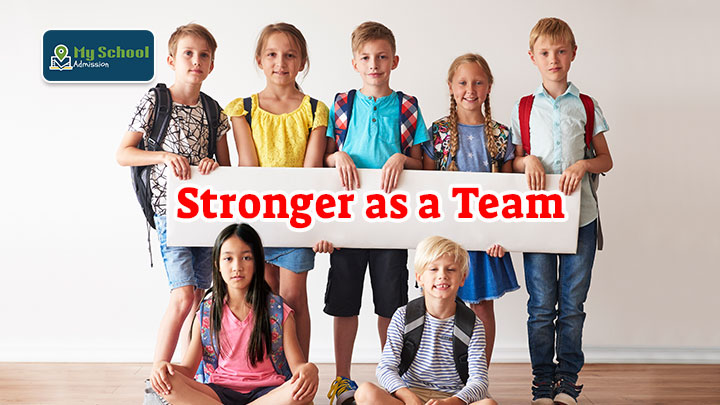Walk into a classroom today, and you’ll feel the energy, it’s not just about books and lectures anymore. A lot of that spark comes from Team-building tasks These aren’t just “team assignments”, they’re real moments where kids learn to connect, share ideas, and figure things out together. Whether they’re building a project or having a simple group discussion, they’re also learning how to speak up, listen closely, and work with people who think differently than they do.
And it’s in those everyday moments, cheering on a quiet classmate, solving a tricky problem, or having a friend.
What is Group Work in the Classroom?
In today’s classrooms, things feel a little more alive and a big reason for that is the growing use of Interactive peer activities. These moments aren’t just about filling time or checking boxes. They’re about helping students build the kinds of skills that really matter in life.
So, what is group work, exactly? It’s when students come together to share ideas, tackle challenges, and learn side by side. But good group work goes deeper than just sitting in a circle. It’s thoughtful. It’s active. And it makes sure everyone has a chance to contribute.
Some of the biggest Benefits of collaborative learning include:
- Learning how to communicate and collaborate with others
- Thinking creatively and solving problems as a team
- Taking ownership and being accountable for your role
When done well, activities don’t just support academic learning, they help students grow emotionally and socially, too. And once you see what group work is and how it builds confidence, empathy, and teamwork, it’s easy to understand why it belongs in every modern classroom.
Understanding the Dynamics of Group Work
When students come together to learn, it’s about more than just memorizing facts, it turns into a shared experience. That’s the heart of group activities for students. The real power of group work is how it gets kids ready for what’s next. From building social skills to boosting confidence, the advantages of group work are huge:
- Sharing responsibility and working as a team
- Improving communication and solving problems together
- Getting ready for college, careers, and life beyond school
These early chances to collaborate help students see things from different points of view, tackle challenges as a group, and become more engaged learners. When you really get what group, work is and the many benefits it brings, it’s clear why group activities for students are a must-have in classrooms today and well into the future.
Advantages of group work for Enhanced Learning
Peer-based activities do way more than just help with schoolwork; they build important life skills that stay with kids long after class is over. When students work together, they learn how to share their ideas clearly, really listen to others, and cooperate as a team.
Some of the biggest brainstorming sessions include better communication, more confidence, stronger social skills, and learning by doing. These experiences create a real sense of community in the classroom and help students stay engaged, think deeply, and get ready for the world beyond school.
With the right support, the benefits of group work can last a lifetime. Over time, students grow more open-minded, adaptable, and better at tackling challenges together. That’s why brainstorming sessions are such an important part of today’s education, they teach kids how to learn with and from one another.
Key Advantages of Group Work in Detail
1) Improved Communication and Interpersonal Skills
In group activities for students, kids get lots of chances to speak up and share their ideas clearly. They also learn how to really listen to others, which is just as important. Plus, they practice giving helpful feedback and accepting it from friends. Working together teaches them how to negotiate and find common ground.
2) Enhanced Critical Thinking and Problem-Solving
When students come together, they bring different viewpoints to the table. This mix encourages them to think more deeply and see things from fresh perspectives. Groups can solve tougher problems than one person alone because everyone’s ideas combine to create smarter solutions and sharper thinking.
3) Boosted Confidence and Self-Esteem
Sometimes shy students feel more comfortable sharing their thoughts in smaller groups. When their classmates appreciate their input, it really helps boost their confidence. Plus, working toward a shared goal gives everyone a great sense of accomplishment and pride.
4) Development of Leadership and Teamwork
What’s group work without teamwork? In groups, students naturally take on different roles, whether it’s leading discussions, taking notes, or keeping track of time. They learn to manage tasks, support one another, and work as a team. These experiences prepare them well for future group projects, both in school and in life.
5) Deeper Understanding and Retention of Material
Explaining ideas to classmates is one of the best ways to truly understand a topic. Group talks help clear up confusion and make learning stick better. When students actively join in, they’re more likely to remember what they’ve studied.
6) Exposure to Diverse Perspectives
Working with classmates from different backgrounds opens students’ minds to new ideas and ways of thinking. It helps them develop empathy and respect for others, which is so important in our diverse world today.
7) Boosting Engagement and Motivation
Let’s be honest, peer-based activities make learning more fun and less like a routine. The social side gets kids involved and excited, and when they’re responsible to each other, they usually try harder and stay motivated.
All these benefits make brainstorming an awesome way to learn and grow together. It’s not just a classroom strategy, it’s a life skill that helps students thrive inside and outside of school.
Making Group Activities Work for Students
To really make the most of peer-based activities, it takes more than just putting kids into teams and hoping for the best. Teachers play a huge part, they help set the tone, lay out clear goals, assign roles, and check in to guide the process. With the right kind of support, students don’t just get the task done, they grow through the experience.
One of the smartest ways to approach group work is by choosing tasks that actually need a group to succeed. If one student could do it alone, it’s probably not the right fit. Instead, go for challenges that spark conversation, encourage different viewpoints, and require students to bring their own strengths to the table. That’s where the real skills come in.
Here are a few simple ways to make collaborative learning more meaningful:
- Clear Learning Goals: Be upfront with students about what they should aim to achieve.
- Structured Tasks: Keep instructions clear, give them a timeline, and outline what success looks like.
- Assigned Roles: Roles like facilitator, note-taker, or presenter help keep everyone involved and focused.
- Monitor and Guide: Walk around, listen in, and step in gently when needed. A little support goes a long way.
- Provide Feedback: Let them know how they did as a team, not just in the final result, but in how they worked together.
- Encourage Reflection: Give them space to think about what worked, what didn’t, and how they’d do it better next time.
At the end of the day, when we truly understand what group work is, and recognize the real advantages of group work, we see why it’s such a valuable part of modern education. It’s not just about finishing an assignment, it’s about helping students learn how to collaborate, communicate, and grow together.
Are you ready to explore schools that truly embrace collaborative learning?
Choosing the right school for your child is about so much more than just test scores and textbooks. It’s about finding a place where peer-based activities are encouraged, where teamwork and critical thinking are part of everyday learning, and where your child can grow, not just academically, but socially too.
That’s where My School Admission comes in. We make the school search simpler by giving you access to detailed school profiles, honest reviews from other parents, and expert insights. We shine a light on schools that go beyond the basics - places that believe in hands-on learning, real collaboration, and meaningful group work.
So, if you're looking for a school that truly supports your child’s all-round development, take a look at My School Admission. We’ll help you find a place where your child can learn, connect, and build the skills they’ll carry through life.






Leave a comment